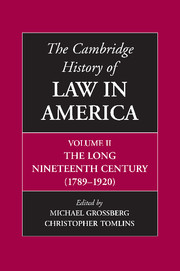Book contents
- Frontmatter
- 1 Law and the American State, from the Revolution to the Civil War: Institutional Growth and Structural Change
- 2 Legal Education and Legal Thought, 1790–1920
- 3 The Legal Profession: From the Revolution to the Civil War
- 4 The Courts, 1790–1920
- 5 Criminal Justice in the United States, 1790–1920: A Government of Laws or Men?
- 6 Citizenship And Immigration Law, 1800–1924: Resolutions Of Membership And Territory
- 7 Federal Policy, Western Movement, and Consequences for Indigenous People, 1790–1920
- 8 Marriage and Domestic Relations
- 9 Slavery, Anti-Slavery, and the Coming of the Civil War
- 10 The Civil War And Reconstruction
- 11 Law, Personhood, and Citizenship in the Long Nineteenth Century: the Borders of Belonging
- 12 Law in Popular Culture, 1790–1920: The People and the Law
- 13 Law and Religion, 1790–1920
- 14 Legal Innovation and Market Capitalism, 1790–1920
- 15 Innovations in Law and Technology, 1790–1920
- 16 The Laws of Industrial Organization, 1870–1920
- 17 The Military in American Legal History
- 18 The United States and International Affairs, 1789–1919
- 19 Politics, State-Building, and the Courts, 1870–1920
- Bibliographic Essays
- Notes on Contributors
- Index
Bibliographic Essays
Published online by Cambridge University Press: 28 November 2008
- Frontmatter
- 1 Law and the American State, from the Revolution to the Civil War: Institutional Growth and Structural Change
- 2 Legal Education and Legal Thought, 1790–1920
- 3 The Legal Profession: From the Revolution to the Civil War
- 4 The Courts, 1790–1920
- 5 Criminal Justice in the United States, 1790–1920: A Government of Laws or Men?
- 6 Citizenship And Immigration Law, 1800–1924: Resolutions Of Membership And Territory
- 7 Federal Policy, Western Movement, and Consequences for Indigenous People, 1790–1920
- 8 Marriage and Domestic Relations
- 9 Slavery, Anti-Slavery, and the Coming of the Civil War
- 10 The Civil War And Reconstruction
- 11 Law, Personhood, and Citizenship in the Long Nineteenth Century: the Borders of Belonging
- 12 Law in Popular Culture, 1790–1920: The People and the Law
- 13 Law and Religion, 1790–1920
- 14 Legal Innovation and Market Capitalism, 1790–1920
- 15 Innovations in Law and Technology, 1790–1920
- 16 The Laws of Industrial Organization, 1870–1920
- 17 The Military in American Legal History
- 18 The United States and International Affairs, 1789–1919
- 19 Politics, State-Building, and the Courts, 1870–1920
- Bibliographic Essays
- Notes on Contributors
- Index
Summary
LAW AND THE AMERICAN STATE, FROM THE REVOLUTION TO THE CIVIL WAR
General
There are few broad comparative studies that would allow us to better understand early American political development from a transnational or global perspective. One valuable overview is Michael Mann, The Sources of Social Power, Volume II: The Rise of Classes and Nation States (New York, 1993). One source for a concise account of the British case in the mid-nineteenth century is the chapter titled “The Nature of the State,” in K. Theodore Hoppen, The Mid- Victorian Generation, 1846–1886 (Oxford, 1998), 91–124. Especially in the United States, social scientists’ interest in the autonomous capacities of the state increased starting in the 1980s. This was evident in the essays collected in Peter Evans, Dietrich Reuschemeyer, and Theda Skocpol, eds., Bringing the State Back In (New York, 1985). More recently, theorists have warned against attributing too much coherence and power to formal state organizations: see George Steinmetz, ed., State/Culture: State-Formation after the Cultural Turn (Ithaca, 1999) and Joel S. Migdal, State in Society: Studying How States and Societies Transform and Constitute One Another (New York, 2001). A stimulating discussion of the deficiencies of conventional notions of state power may be found in Peter Baldwin, “Beyond Weak and Strong: Rethinking the State in Comparative Policy History,” Journal of Policy History 17 (2005), 12–33.
- Type
- Chapter
- Information
- The Cambridge History of Law in America , pp. 697 - 820Publisher: Cambridge University PressPrint publication year: 2008

